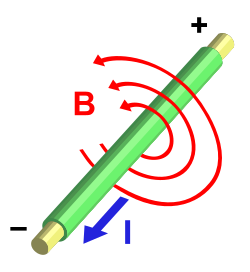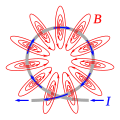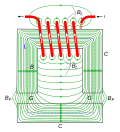Electromagnet

Electromagnets are temporary and artificial magnets. They are magnets that are only magnetic when there is a coil of wire with electricity running through it. The coil of wire is called a solenoid. The strength of the magnet is proportional to the current flowing in the circuit. The electricity running through the wire is called a current. The current is the flow of electrons, which are negatively charged particles. Electromagnets are used for a variety of purposes. In a simple example, an electromagnet can pick up pieces of iron, nickel, and cobalt.
Electromagnets can be made stronger by adding more coils to the copper wire, or adding an iron core through the coils (for example a nail). The current can also be increased to make the magnetism stronger. British electrician William Sturgeon invented the electromagnet in 1825.
An electromagnet is useful because it can be turned on and off easily (using an electric current), whereas a permanent magnet cannot be turned off and will continue to affect its immediate environment.
Different alloys act differently. Iron stops being an electromagnet very quickly, but steel takes time to wear off. To make an electromagnet, copper wire is wound around an iron rod. The two ends of the wire are connected to the + (positive) and - (negative) side of the battery.
Usage
Electromagnets are used in everyday items such as burglar alarms, electric relays and fire bells. Electric motors are basically electromagnets. Their ability to change from the state of non-magnetic to magnetic just by passing an electric current through it allows it to be used in many different items. This ability is used in relays.
Electromagnets can also be used to make electricity. Movement of a magnet back and forth in front of the electromagnet will make an electric current.
Why electromagnets work
Electromagnets work because when electricity flows through a wire it makes a magnetic field around the wire. The direction of the magnetic field can be found by using the right-hand rule. This means that if a person points the thumb of their right hand in the direction of the current, the magnetic field would go around the wire the same way their fingers would wrap around the wire.
The magnetic field made by a single wire is not usually very strong. To make an electromagnet normally the wire is wrapped in many loops to make the fields of each piece of wire add together into one stronger magnetic field.
More reading
- Iggulden, Hal; Iggulden, Conn (2007). "A Simple Electromagnet". The Dangerous Book for Boys. New York: HarperCollins. p. 148. ISBN 978-0061243585.
Electromagnet Media
Magnetic field produced by a solenoid (coil of wire). This drawing shows a cross-section through the center of the coil. The crosses are wires in which current is moving into the page; the dots are wires in which current is moving up out of the page.
Cross section of a lifting electromagnet, showing the cylindrical construction. The windings (C) are flat copper strips to withstand the Lorentz force of the magnetic field. The core is formed by the thick iron housing (D) that wraps around the windings.
Large aluminum busbars carrying current into the electromagnets at the LNCMI (Laboratoire National des Champs Magnétiques Intenses) high field laboratory
Other websites
![]() Media related to Electromagnets at Wikimedia Commons
Media related to Electromagnets at Wikimedia Commons









